Exercises (2274)
Lunge (right) ► split squat / split lunge
Power
Individual work

Stand upright, arms supported on the hips, lunge forward (with the right leg), bend the front (and back) leg to a right angle, hold the position.
Attention:
Always keep the front knee behind the tip of the foot and centred over the foot. Lower your body in the centre (follow the back knee like a plumb line, keep your upper body upright, tense your stomach).
Lighten:
Lower your upper body less (greater angle in the knees).
Harden:
Additional weight (on the shoulders, with hanging arms or in a forward or upright position); unstable base for supporting the front leg.
1 weight vest/weight disc/(medicine) ball/barbell/sandbag/fighting backpack/2 dumbbells ► make the exercise more difficult (additional weight)
1 ball/balance cushion/balance board ► make the exercise more difficult (unstable surface)
Lunge (right) ► split squat / split lunge
Power
Individual work

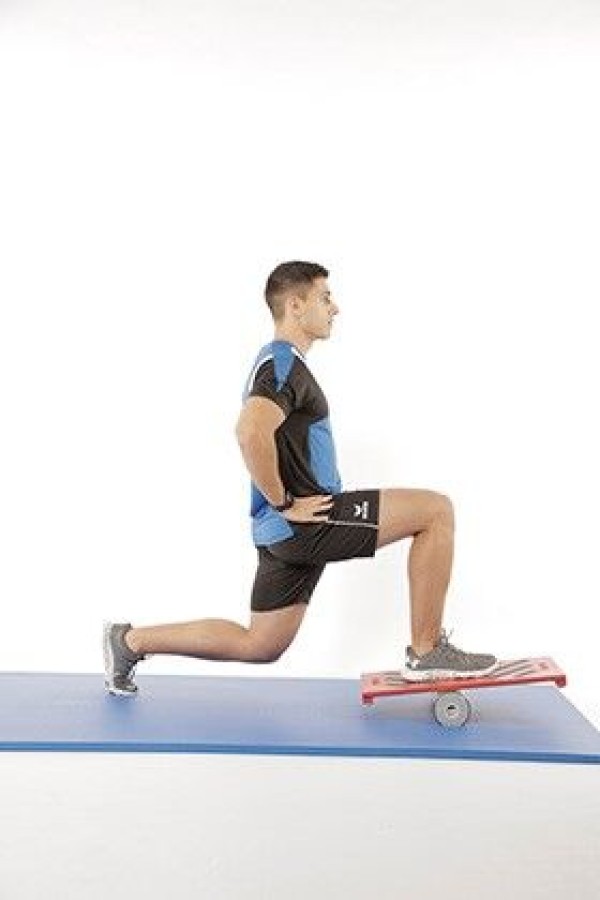
Lunge, upper body upright, front (right) leg on the balance board (board on the wedges) and bent to approximately a right angle, arms supported on the hips, crossed on the chest or behind the head or in front, hold the position.
Attention:
Upright upper body (tense torso), front knee always remains behind the tip of the foot and centred over the foot, distribute weight over the entire front foot.
Lighten:
Without a balance board; lower your upper body less (greater angle at the knees).
Harden:
Balance board on the roller (instead of on the wedges); additional weight (on the shoulders, with hanging arms or in a forward or upright position).
Variant:
Bend and straighten the front leg (raise and lower the upper body).
1 balance board
2 wedges (semicircular)
1 roller ► make the exercise easier
1 weight vest/weight disc/(medicine) ball/barbell/sandbag/2 dumbbells ► make the exercise more difficult (additional weight)
Lunge (right) ► split squat / split lunge
Power
Individual work


Start in a standing position on the balance board (lengthways on the board), with the leg resting flat on one end of the balance board (right) and the leg supported on the tips of the toes at the other end (left). Bend both legs so that the knee of the back leg (left) touches the balance board. Then straighten both legs back to the starting position.
Lighten:
Without the balance board; lower your upper body less (greater angle at the knees).
Lighten:
Additional weight (on the shoulders, with arms hanging down or in a forward or upright position).
1 balance board
1 weight vest/weight disc/(medicine) ball/sandbag/2 dumbbells ►Make the exercise more difficult (additional weight)
Lunge alternating with jump (alternating jump) ► jumping lunge
Power
Individual work



Lunge (upper body upright, stomach tensed), arms supported on the hips, folded across the chest, bend the front (and back) leg to a right angle, straighten the legs for a two-legged jump, change leg position during the jump (move the back leg forwards and the front leg backwards), land in the starting position (mirror-inverted).
Attention:
Always keep your front knee behind the tip of your foot and centred over your foot. Keep your upper body as stable as possible.
Lighten:
Higher basic position/lower your upper body less (greater angle in the knees).
Harden:
Additional weight (on the shoulders, with hanging arms or in a forward or upright position).
Variation:
Jump height can be varied: high jumps with plenty of time to change leg position or only small jumps with quick leg shifts.
1 weight vest/weight disc/(medicine) ball/sandbag/fighting backpack/2 dumbbells ► make the exercise more difficult (additional weight)
Lunge alternating with jump (alternating jump) ► jumping lunge / lunge jump
Power
Individual work
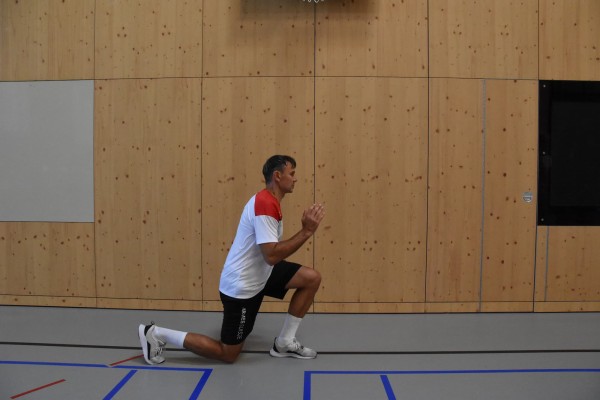
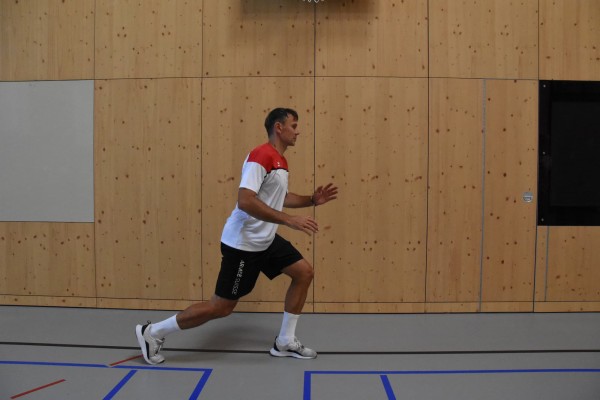
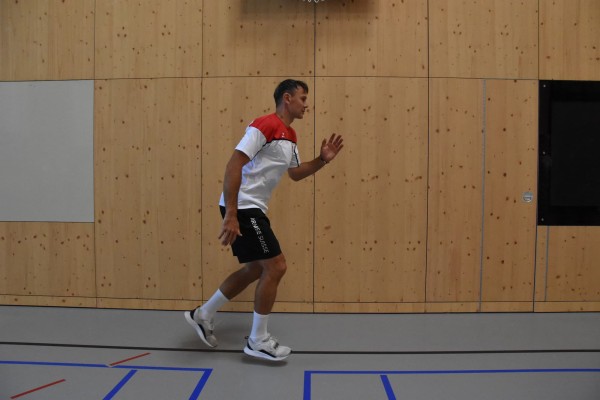
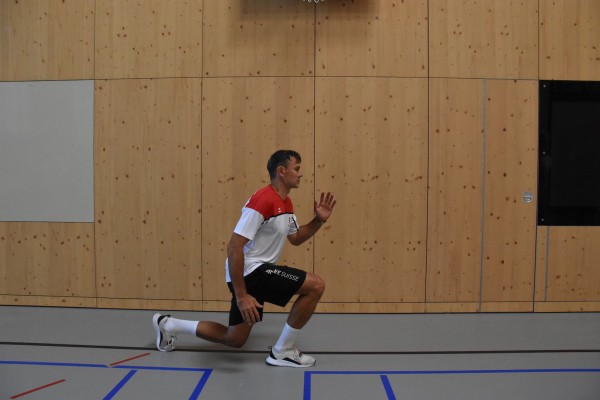
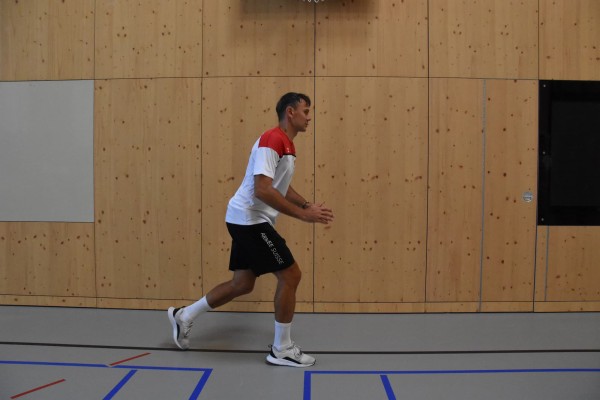

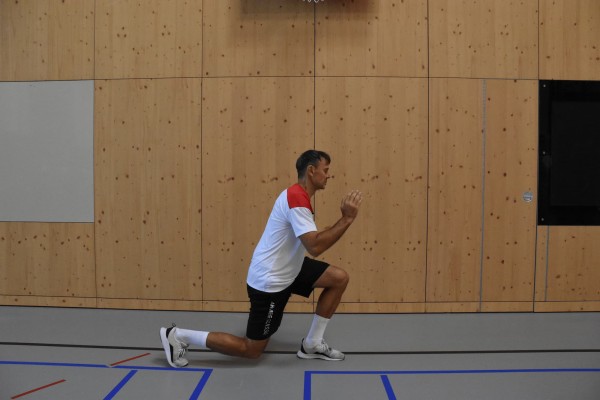
Lunge (upper body tilted slightly forwards, stomach tensed), arms bent (front arm = side of the back leg; back arm = side of the raised leg), bend the front (and back) leg to a right angle, straighten the legs for a two-legged jump, change leg position during the jump (back leg forwards and front leg backwards), landing in the starting position (mirror-inverted). Continuously switch between the two positions without remaining in the lunge position for too long.
Attention:
Keep your upper body as stable as possible.
Lighten:
Higher basic position/lower your upper body less (greater angle in the knees).
Harden:
Additional weight (hold in arms).
Variation:
Jump height can be varied: high jumps with plenty of time to change leg position or only small jumps with quick leg shifts.
1 weight vest/weight disc/(medicine) ball/sandbag/fighting backpack/2 dumbbells ► make the exercise more difficult (additional weight)
Lunge alternating in jump with rotation of the upper body (alternating jump) ► jumping lunge
Power
Individual work


Lunge, upper body rotated towards the bent leg with arms as straight as possible (looking to the side), front (and back) leg bent to a right angle, legs stretched out for a two-legged jump, change leg position during the jump (move back leg forwards and front leg backwards) and move the upper body and arms to the other side, landing in the starting position (mirror-inverted).
Attention:
Always keep the front knee behind the tip of the foot and in the centre of the foot.
Lighten:
Higher starting position/lower upper body less (larger angle in the knees).
Harden:
Additional weight (hold in your hands).
Variation:
Jump height can be varied: high jumps with plenty of time to change leg position or only small jumps with quick leg shifts.
1 weight vest/weight disc/(medicine) ball/1-2 dumbbells ► make the exercise more difficult (additional weight)
Lunge from a standing position (left) ► lunge
Power
Individual work

Stand, upper body upright and stomach tensed, weapon held high or in front, lunge forward (with the left leg), bend the front (and back) leg to approximately a right angle, push off the front (left) leg to return to the starting position.
Attention:
Always keep the front knee behind the tip of the foot and centred over the foot.
Lighten:
Lower the upper body less (greater angle at the knees).
Variant:
With each lunge, the assault rifle is passed between the legs.
1 assault rifle (neutralised)
Lunge from a standing position (left) ► lunge
Power
Individual work


Stand upright, upper body upright and stomach tensed, arms supported on the hips, folded across the chest or in front, lunge forwards (with the left leg), bend the front (and back) leg to a right angle, push off the front (left) leg to return to the starting position.
Attention:
Always keep the front knee behind the tip of the foot and centred over the foot.
Lighten:
Lower the upper body less (greater angle at the knees).
Harden:
Additional weight (on the shoulders, with hanging arms or in a forward or upright position).
1 weight vest/weight disc/(medicine) ball/barbell/sandbag/fighting backpack/2 dumbbells ► make the exercise more difficult (additional weight)
Lunge from a standing position (left) ► lunge
Power
Individual work


The barbell rests on the upper back. From a hip-width upright stance, take a large step forwards (with your left leg), lowering your hips so low that your back knee almost touches the floor (both legs at right angles, so to speak). The front (left) leg is then pushed backwards to return to the starting position.
Starting position:
- Stand with hips wide apart
- Feet pointing forwards
- Barbell placed on upper back, grasp barbell with wide overhand grip
- Look (always) straight ahead in neutral position
Finishing position:
- The front knee is bent at a right angle directly over the heel
- The back knee almost touches the floor
- The upper body remains upright
Attention:
The front knee always remains behind the toe and centred over the foot.
Variant:
Replace the barbell with dumbbells, which are held next to the body with outstretched arms (or also hold the kettlebell in front of the chest or in a holding position).
1 barbell
2 dumbbells/kettlebell ► variation of the exercise
Lunge from a standing position (left) ► lunge
Power
Individual work

Stand, upper body upright and stomach tensed, pistol held out in front of you with arms outstretched, lunge forwards (with the left leg), bend the front (and back) leg to a right angle, push off the front (left) leg to return to the starting position.
Attention:
Always keep the front knee behind the tip of the foot and centred over the foot.
Lighten:
Lower the upper body less (greater angle at the knees).
Variant:
With each lunge, the pistol is passed between the legs (change hands between the legs).
1 pistol (neutralised)
Lunge from a standing position (left) ► lunge
Power
Individual work


Standing, upper body upright and abdomen tensed, with arms hanging at the side of the body, grasp a weight (dumbbell or kettlebell) with both hands. Lunge forwards (with the left leg), bend the front (and back) leg to approximately a right angle (buttocks at knee height of the front leg, knee of the back leg almost touching the floor), then push off the front (left) leg to return to the standing position in the starting position.
Attention:
Always keep the front knee behind the tip of the foot and centred over the foot.
Lighten:
Lower the upper body less (greater angle in the knees); less or no weight.
Harden:
Additional weight.
Variant I:
Extend and bend the legs (raise and lower the upper body) in the lunge position without bringing the front leg back to the starting position in the upright position.
Variant II:
Weights with outstretched arms at chest height in front of you (if necessary, rotate your upper body to the side and back in a lunge).
2 dumbbells/kettlebells
1 weight waistcoat ► to make the exercise more difficult (additional weight)
Lunge from a standing position (right) ► lunge
Power
Individual work

Stand, upper body upright and stomach tensed, weapon held high or in front, lunge forward (with the right leg), bend the front (and back) leg to approximately a right angle, push off the front (right) leg to return to the starting position.
Attention:
Always keep the front knee behind the tip of the foot and centred over the foot.
Lighten:
Lower the upper body less (greater angle at the knees).
Variant:
With each lunge, the assault rifle is passed between the legs.
1 assault rifle (neutralised)
Lunge from a standing position (right) ► lunge
Power
Individual work

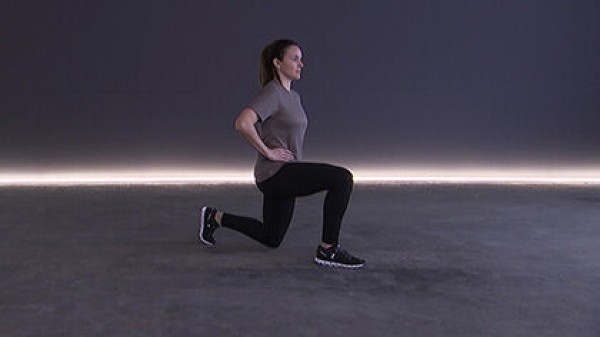
Stand upright, upper body upright and stomach tensed, arms supported on the hips, folded across the chest or in front, lunge forwards (with the right leg), bend the front (and back) leg to a right angle, push off the front (right) leg to return to the starting position.
Attention:
Always keep the front knee behind the tip of the foot and centred over the foot.
Lighten:
Lower the upper body less (greater angle at the knees).
Harden:
Additional weight (on the shoulders, with hanging arms or in a forward or upright position).
1 weight vest/weight disc/(medicine) ball/barbell/sandbag/fighting backpack/2 dumbbells ► make the exercise more difficult (additional weight)
Lunge from a standing position (right) ► lunge
Power
Individual work


The barbell rests on the upper back. From a hip-width upright stance, take a large step forwards (with your right leg), lowering your hips so low that your back knee almost touches the floor (both legs at right angles, so to speak). The front (right) leg is then pushed backwards to return to the starting position.
Starting position:
- Stand with hips wide apart
- Feet pointing forwards
- Barbell placed on upper back, grasp barbell wide in overhand grip
- Look (always) straight ahead in neutral position
Finishing position:
- The front knee is bent at a right angle directly over the heel
- The back knee almost touches the floor
- The upper body remains upright
Attention:
The front knee always remains behind the toe and centred over the foot.
Variant:
Replace the barbell with dumbbells, which are held next to the body with outstretched arms (or also hold the kettlebell in front of the chest or in a holding position).
1 barbell
2 dumbbells/kettlebell ► variation of the exercise
Lunge from a standing position (right) ► lunge
Power
Individual work

Stand, upper body upright and stomach tensed, pistol held out in front of you with arms outstretched, lunge forwards (with the right leg), bend the front (and back) leg to a right angle, push off the front (right) leg to return to the starting position.
Attention:
Always keep the front knee behind the tip of the foot and centred over the foot.
Lighten:
Lower the upper body less (greater angle in the knees).
Variant:
With each lunge, the pistol is passed between the legs (change hands between the legs).
1 pistol (neutralised)
Lunge from a standing position (right) ► lunge
Power
Individual work


Standing, upper body upright and abdomen tensed, with arms hanging at the side of the body, grasp a weight (dumbbell or kettlebell) with both hands. Lunge forwards (with the right leg), bend the front (and back) leg to approximately a right angle (buttocks at knee height of the front leg, knee of the back leg almost touching the floor), then push off the front (right) leg to return to the standing position in the starting position.
Attention:
Always keep the front knee behind the tip of the foot and centred over the foot.
Lighten:
Lower the upper body less (greater angle in the knees); less or no weight.
Harden:
Additional weight.
Variant I:
Extend and bend the legs (raise and lower the upper body) in the lunge position without bringing the front leg back to the starting position in the upright position.
Variant II:
Weights with outstretched arms at chest height in front of you (if necessary, rotate your upper body to the side and back in a lunge).
2 dumbbells/kettlebells
1 weight waistcoat ► to make the exercise more difficult (additional weight)
Lunge from a standing position alternating
Power
Individual work

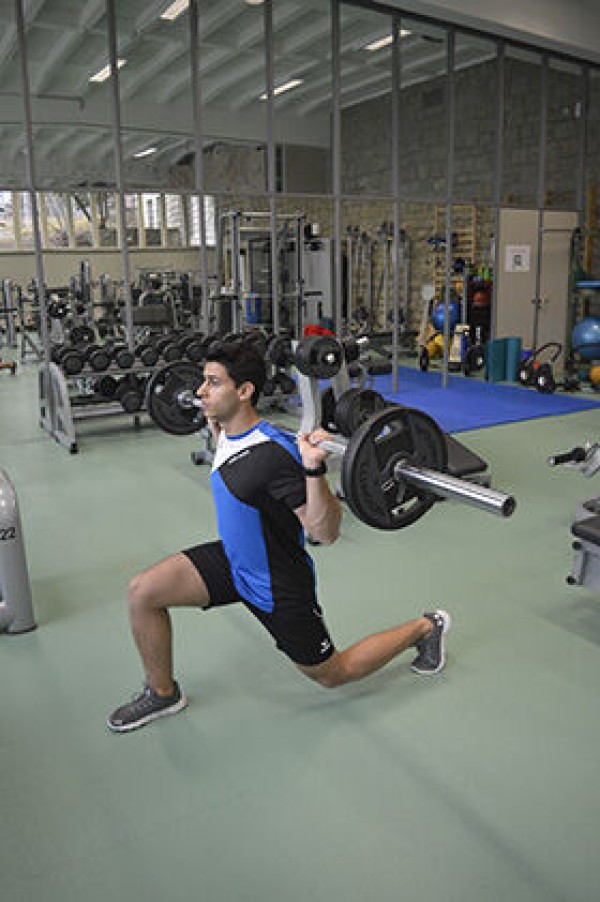
The barbell rests on the upper back. From a hip-width upright stance, take a big step forwards, lowering your hips so low that your back knee almost touches the floor (both legs at right angles, so to speak). The front leg is then pushed backwards to return to the starting position. Switch sides after each exercise.
Starting position:
- Stand with hips wide apart
- Feet pointing forwards
- Barbell placed on upper back, grasp barbell wide in overhand grip
- Look (always) straight ahead in neutral position
Finishing position:
- The front knee is bent at a right angle directly over the heel
- The back knee almost touches the floor
- The upper body remains upright
Attention:
The front knee always remains behind the toe and centred over the foot.
Variant:
Replace the barbell with dumbbells, which are held next to the body with arms outstretched.
1 Barbell
2 Dumbbell ► variation of the exercise
Lunge from a standing position alternating ► lunge
Power
Individual work


Stand, upper body upright and abdomen tensed, pistol held out in front with arms outstretched, lunge forwards, bend front (and back) leg to a right angle, push off front leg to return to standing position. On the next repetition, switch sides (bring the other leg forwards).
Attention:
Always keep the front knee behind the toe and centred over the foot.
Lighten:
Lower the upper body less (greater angle in the knees).
Harden:
Jump off with the legs when lifting the upper body to change the leg position (dynamically switch from one front leg to the other in the jump).
Variant I:
With each lunge, the pistol is passed between the legs (change hands between the legs).
Variant II:
Instead of bringing the front leg back to the standing position, the back leg is brought forwards and the knee bent (new lunge), creating a continuous movement.
1 pistol (neutralised)
Lunge from a standing position alternating ► lunge
Power
Individual work


Stand, upper body upright and abdomen tensed, weapon held high or forward, lunge forwards, bend the front (and back) leg to approximately a right angle, push off the front leg to return to the starting position. On the next repetition, switch sides (bring the other leg forwards).
Attention:
Always keep the front knee behind the toe and centred over the foot.
Lighten:
Lower the upper body less (greater angle in the knees).
Harden:
Jump off with the legs when lifting the upper body to change the leg position (dynamically switch from one front leg to the other in the jump).
Variant I:
With each lunge, the assault rifle is performed between the legs.
Variant II:
Instead of bringing the front leg back to the standing position, the back leg is brought forward and the knee is bent (new lunge), creating a continuous movement.
1 assault rifle (neutralised)
Lunge from a standing position alternating ► lunge
Power
Individual work




Standing, upper body upright and abdomen tensed, with arms hanging at the side of the body, grasp a weight (dumbbell or kettlebell) with both hands. Lunge forwards, bend the front (and back) leg to approximately a right angle (buttocks at knee height of the front leg, knee of the back leg almost touching the floor), then push off the front leg to return to the standing position. Switch sides for the next exercise.
Attention:
Always keep the front knee behind the tip of the foot and centred over the foot.
Lighten:
Lower the upper body less (greater angle in the knees); less or no weight.
Harden:
Additional weight.
Variation:
Weights with arms outstretched at chest height in front of you (if necessary, rotate your upper body to the side and back in a lunge)
2 dumbbells/kettlebells
1 weight waistcoat ► to make the exercise more difficult (additional weight)
Lunge from a standing position with knee lift ► lunge
Power
Individual work


Stand upright, arms supported on the hips (or hanging), raise one leg (knee at hip height, 90 degree angle upper body to thigh and thigh to lower leg), maintain balance in a one-legged stance with knee in high position for a short time, take a big lunge forwards with the raised leg, bend the front (and back) leg to a right angle, push off the front leg to return to the starting position. Switch sides for the next exercise.
Attention:
Always keep the front knee behind the toe and centred over the foot, upper body upright and abdomen tensed.
Lighten:
Lift your knees less, lower your upper body less (greater angle in the knees).
Harden:
Additional weight (on the shoulders, with hanging arms or holding forwards or upwards).
1 weight vest/weight disc/(medicine) ball/barbell/sandbag/fighting backpack/2 dumbbells ► make the exercise more difficult (additional weight)
Lunge with rotation of the upper body (left) ► lunge
Power
Individual work


Lunge (left) with an upright upper body, front (left) leg bent (approximately right angle at the knee joint), back (right) leg almost fully extended, standing on tiptoe, feet in the loops, holding the gymnastics pole with your hands on your shoulders behind your head, move/rotate your upper body alternately from one side to the other (head accompanies the movement).
Attention:
The movement is only performed with the upper body, hips and knees point forwards during the entire movement. The front knee always remains behind the tip of the foot and centred over the foot. Lower your body in the centre (like a plumb line following the back knee, upper body remains upright, tighten your stomach).
Lighten:
Select less strong elastic bands; roll up the elastic bands less.
Harden:
Choose stronger elastic bands, roll up the elastic bands more.
Variant:
To relieve pressure on the neck, the gymnastic stick can also be held in front of the body at sternum level (baby position).
1 gymnastic bar with elasticated straps
Lunge with rotation of the upper body (right) ► lunge
Power
Individual work


Lunge (right) with an upright upper body, front (right) leg bent (approximately right angle at the knee joint), back (left) leg almost fully extended, standing on tiptoe, feet in the loops, holding the gymnastics pole with your hands on your shoulders behind your head, move/rotate your upper body alternately from one side to the other (head accompanies the movement).
Attention:
The movement is only performed with the upper body, hips and knees point forwards during the entire movement. The front knee always remains behind the tip of the foot and centred over the foot. Lower your body in the centre (like a plumb line following the back knee, upper body remains upright, tighten your stomach).
Lighten:
Select less strong elastic bands; roll up the elastic bands less.
Harden:
Choose stronger elastic bands, roll up the elastic bands more.
Variant:
To relieve pressure on the neck, the gymnastic stick can also be held in front of the body at sternum level (baby position).
1 gymnastic bar with elasticated straps
Lunge backwards (left) ► dumbbell reverse lunge
Power
Individual work

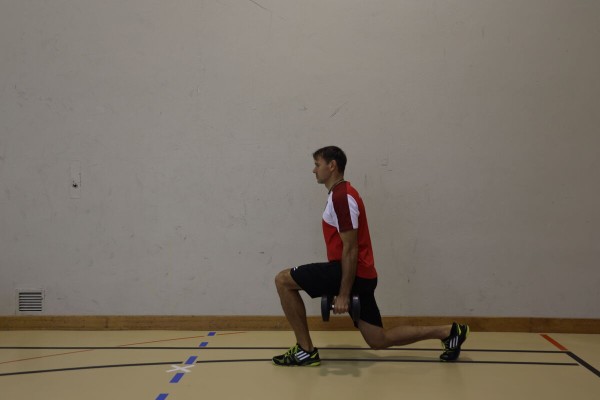
Stand upright shoulder-width apart, arms hanging next to the body, holding the weight (dumbbell or kettlebell) with each hand, move one foot (right) backwards and place it on the front foot, simultaneously bend the (front left) standing leg to approximately a right angle in the knee joint, then straighten the front leg (left) and move the back leg (right) forwards again to return to the starting position.
Attention:
Upright posture, front knee always remains behind the tip of the foot and centred over the foot.
Lighten:
Lower the upper body less (greater angle in the knee)/lean back less; hold less or no weight in the hands.
Harden:
More weight; additional weight.
Variation:
While bending the front leg, bend the arms at the same time for additional training of the upper body (arm flexors). While stretching the leg, also return the arms to the starting position.
2 dumbbells/kettlebells
1 weight waistcoat ► to make the exercise more difficult (additional weight)
Lunge backwards (left) ► dumbbell reverse lunge
Power
Individual work
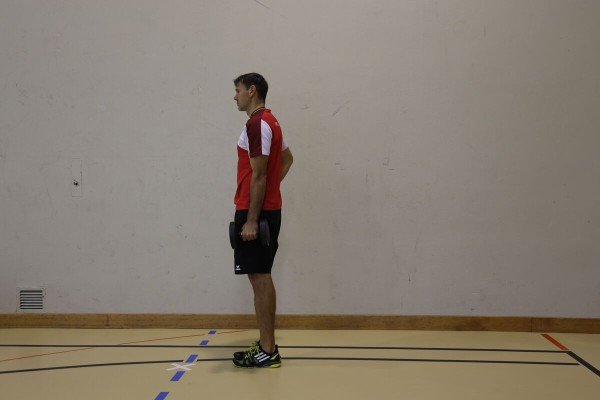

Stand upright shoulder-width apart, arms hanging beside the body, holding the weight (dumbbell or kettlebell) in the left hand, move one foot (right) backwards and place it on the front foot, simultaneously bend the (front left) standing leg to approximately a right angle in the knee joint, then straighten the front leg (left) and move the back leg (right) forwards again to return to the starting position.
Attention:
Upright posture, front knee always remains behind the tip of the foot and centred over the foot.
Lighten:
Lower the upper body less (greater angle in the knee)/lean back less; hold less or no weight in the hands.
Harden:
More weight; additional weight.
Variation:
While bending the front leg, simultaneously bend the arm with the weight in your hand for additional training of the upper body (arm flexors). While stretching the leg, also return the arm to the starting position.
1 dumbbell/kettlebell
1 weight waistcoat ► to make the exercise more difficult (additional weight)